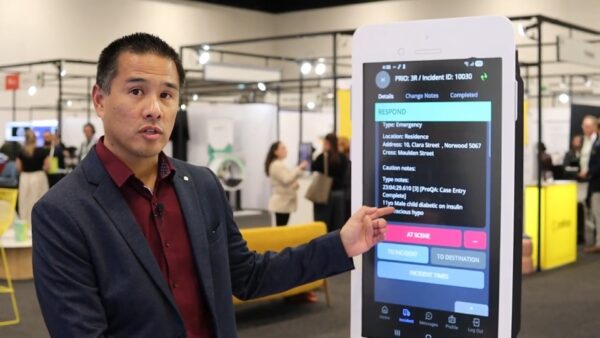Connecting paramedics and volunteers with the vital information they need, quickly and seamlessly, is a critical component of a modern ambulance service allowing them to make better decisions along every step of the Connected Journey. From making processes more efficient to increasing situational awareness in stressful situations and monitoring wellbeing, Connected Paramedics help create safe and efficient ambulance services.
One important part of being connected is sharing the lessons learnt from others. At the recent Council of Ambulance Authorities (CAA) 2021 Virtual Expo, the wider ambulance industry collaborated and shared their extensive knowledge and ideas through an interactive ideas portal themed
‘Mitigating Risk for Paramedics and Volunteers’.
Nearly 100 ideas were captured from ambulance staff across Australia, New Zealand, and Papua New Guinea. This shared knowledge aims to improve the working lives of all paramedics and volunteers. These ideas were captured visually on the CAA-Corvanta Interactive Ideas Board.

This article examines the most prevalent 2021 Interactive Ideas Board themes which were:
- Safety
- Wellbeing
- Education and training
- Streamlining processes
Safety
- Smart video recognition technology: covering on-vehicle to identify oncoming traffic issues, to on-person to capture a troublesome civilian, to in-vehicle monitoring paramedic fatigue, and on-mobile to identify patients for access into public health records.
- Traffic light priority: creating a ‘corridor of green lights’ to reduce chances of collision and improve road safety.
- Real-time mapping overlays: capturing data from integrated duress and body worn cameras which can be remotely activated if paramedics are under threat, so support can be quickly provided.
- Biometric devices: using ‘smart clothing’ to monitor stress and anxiety levels to gain an early picture of staff at risk of assault or injury. AI and ML – Processing real-time data to provide suggestions to avoid dangers or reduce risks.
Wellbeing
The importance of monitoring and gauging wellbeing over time was an important theme including making sure interventions were available when required.
Ideas put forward around wellbeing covered:
- Feedback systems: creating a safe, confidential environment that collects paramedic wellbeing data over time, so improvements occur continuously.
- Mental health management: paramedics are frequently expected to manage cases that are clinically, operationally, and personally complex. These stressful situations can affect their rational and cognitive bandwidth and may affect their response actions. More research was suggested to fully understand this, and how to proactively address these situations.
- Monitoring paramedic health metrics: using smartwatch applications that capture data like heart rate, blood pressure, and other vitals when paramedics and volunteers are on duty to identify trends to predictive intervention.
Education and Training
Continuously improving paramedic and volunteer knowledge and training was highlighted as an important theme throughout the ideas raised. Paramedics from CAA member organisations are well educated and experienced and are more than willing to share their clinical knowledge. The aim here is to create better decision making across the board while increasing professionalism in the ambulance industry.
Ideas put forward included:
- Knowledge sharing: by increasing information exchange between members. This includes ‘communities of practice’ where similar groups connect.
- Public awareness: campaigns to increase awareness of emergency vehicles on the way to a scene, reducing the likelihood of collisions.
- Industry partner engagement: liaising with partners like technology and service providers to guide the paramedicine curriculum.
- Health systems integration: have all information electronically available and linked with other primary healthcare services.
- Shared online platforms for members: an open platform to share written, audio and video content on clinical discussions, presentations and clinical reasoning or decision-making exercises.
Streamlining Processes
Process improvements were highlighted as an important way to improve paramedic and volunteer working conditions. Technology innovations and automation were highlighted as potential areas of improvement across all aspects of ambulance operations. This includes all processes undertaken throughout operations, including shift commencement, medicine and equipment inventories, vehicle maintenance, attending scenes, and end of shift procedures.
Process ideas included:
- Integrated systems: linking all IT systems together, rather than running different platforms that are independent of each other. Systems should also connect with allied health systems to better access patient history that could influence patient outcomes.
- National clinical guidelines: creating consistent processes across the regions resulting in the efficient onboarding of paramedics from another jurisdiction.
- Personal mobile device use: connecting with ambulance specific platforms like Computer Aided Dispatch and in vehicle systems, and
- Automated inventory monitoring and updates: use advanced RFID technology that tracks all onboard medical consumables and equipment, giving paramedics real-time information on expiry dates, usage, and maintenance.
Conclusion
The best ideas to solve a problem are always found when you listen to the people who have to live with them day in, day out. The CAA-Corvanta Interactive Ideas Board was, yet again, a perfect way to extend the reach and hear from all levels of the ambulance industry across ANZ and PNG.
You only need to spend an hour in the shoes of a paramedic to know that the themes which came forward are not a surprise – a knowledgeable, safe, healthy and digitally integrated paramedic is one who is more efficient at their job and, most importantly, in the best position to ensure a safe patient.
The good news is that while some of these ideas are for the long-term, many can be implemented right now.

Meg Schubel
Marketing Manager
Meet the author
Meg is passionate about Corvanta’s technology solutions that connect communities and make a difference in people’s lives. Talk about rewarding! She is responsible for educating the industry on how solutions developed for emergency services can support meeting response targets, improve responder safety and influence better community outcomes. She’s always looking for valuable insights, so please reach out and share your knowledge!



